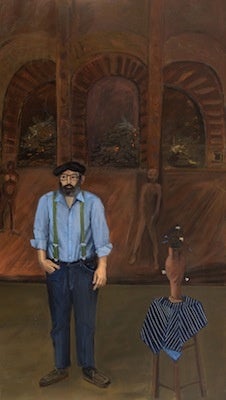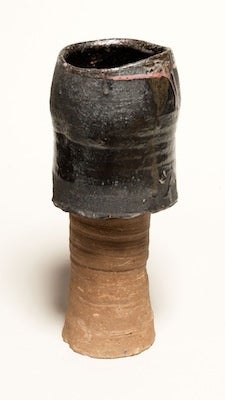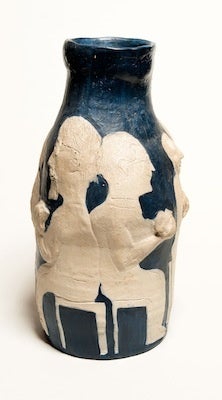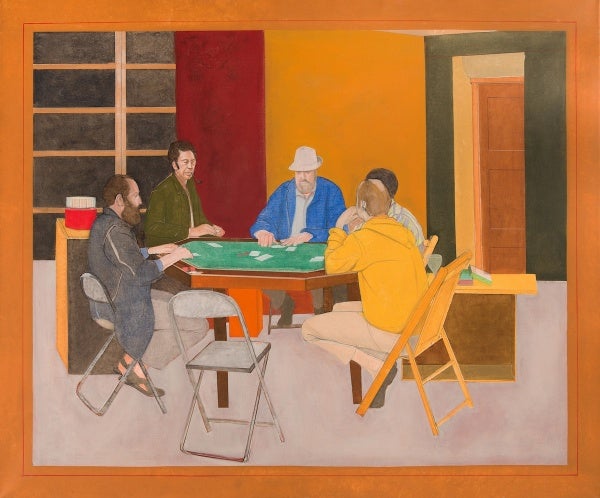The Woodmere’s latest exhibit brings together poker-playing artists and friends
As a young man, Armand Mednick joined a group of fellow art school graduates for weekly critiques that cut to the heart of their art and their lives, and one man’s opinion has shadowed him for fifty years.
A ceramic artist and teacher, working on the potter’s wheel and by hand, Mednick presented his pot to the group and got a little more than he bargained for from Larry Day, whose 1970 oil painting, “Poker Game,” anchors the latest exhibition at Woodmere Art Museum.
Day called Mednick’s work “Jungian,” referring to a school of analytical pyschology.
Mednick, a Holocaust survivor, noted that, “Once you say something that heavy, what is there to say after that than, ‘Let’s play poker?'”
That weekly poker game among a diverse group of influential Philadelphia artists is now in its 50th year, though Mednick is one of the only surviving members of the original party. Now, Woodmere’s “The Poker Game and Its Circle” (July 20-Oct 26) celebrates the group and marks a “joyous” moment for Mednick.
It’s a reunion of sorts, all the more precious to Mednick because many of the friends whose work appears alongside his have been gone for twenty or more years.
Fleeing the Holocaust
Born in Brussels, Belgium in 1933, Mednick’s given name was Avrum, but he adopted the name “Armand” when his family fled his home country during World War II because they were Jewish.
“My father was in the French Resistance, and he was just amazing about surviving.” Most of the artist’s extended family perished in concentration camps.
In 1947, Mednick’s family, including his two sisters, made it safely to New York and then to Philadelphia, with the sponsorship of relatives in the U.S.
The arts ran in the family. Mednick’s cousin, Sol Mednick, founded the photography department at what became the University of the Arts.
A new life
“They sent me to a school in South Philly,” Mednick said, “and I was put in with all these people who all spoke different languages. The only person who spoke English was the teacher. That really accelerates your progress.”
With the help of his melting pot classroom and frequent trips to the movies, Mednick learned English in about six months. Later, he attended Central High School, and it was there that a teacher encouraged him to try painting.
“My father heard about that and thought that was a terrible idea. He wanted me to be a businessman,” Mednick remembers now. But he was hooked, and enrolled at Tyler School of Art, where he “fell in love with ceramics.”
After he graduated in 1958, he made his ultimate goal to have his own kiln and knew he needed to find a good job. He launched his fifty-year career as an art and ceramics teacher at Blue Bell’s Oak Lane Day School.
The “magical” medium
For Mednick, clay is a “magical” medium both for its tactile qualities and its durability. “Of all the arts, I think that’s the one that survives the most,” he said, pointing to archeological sites that yield the secrets of past centuries through their pottery.
Mednick, a widower, retired in 2010 and moved to Mt. Airy from his longtime home near Doylestown. Now he volunteers at Allens Lane Art Center, teaching classes for the visually impaired. In an especially sweet turn of events, he fell in love with one of the students.
“We are a couple now. She is 76, I’m 80,” he said.
The game goes on
He also continues to enjoy the poker games on the first Sunday of the month, which once included Day, Sidney Goodman, Dennis Leon, Jimmy Lueders and David Pease, artists whose work graces Woodmere’s permanent collection today.
“It became more about intimate discussions…to talk about life and important issues of the moment,” he said of the ongoing game.
“The intimacy of men speaking about real stuff, it’s so rare, and I’ve treasured that so much…nobody is macho in our group,” he added.
Remembering the table
He can describe the tranquil, colorful scene in Day’s 1970 painting of the original crew, now on view at Woodmere, as if his friends are still right in front of him.
Of the empty chair shown in the painting, Mednick explained, “That’s Larry, he’s standing behind doing the painting. On the left is myself, with the black beard,” and Leon, Pease and Lueders.
The poker table in the picture has its own story: the men bought a professional one by taking ten cents from each hand for two years.
Lueders, Day and Leon are all gone, but the tradition continues: the game’s youngest current member is 37, and its oldest is 88.
“It’s the ritual that really counts,” Mednick said. The party begins at noon on the first Sunday of every month and continues through rounds of champagne and oysters, lunch, cigars, conversation, cognac and of course, the game.
The exhibit displays about 40 works created by artists associated with the group at one point or another since its founding in 1963, including five pieces from Mednick.
“It’s an intimate show of people who knew each other, that really liked and loved each other a lot,” said Mednick.
Woodmere Art Museum’s “The Poker Game and Its Circle” is on display through October 25. On Saturday, September 28, Ruth Fine, Larry Day’s wife and the former curator of special projects in modern art at the National Gallery of Art in Washington D.C., will present a free gallery talk about her late husband’s work.
WHYY is your source for fact-based, in-depth journalism and information. As a nonprofit organization, we rely on financial support from readers like you. Please give today.








